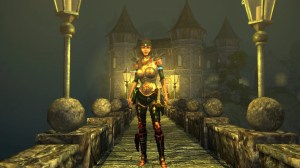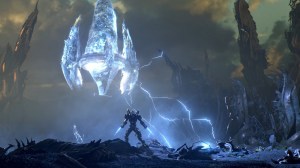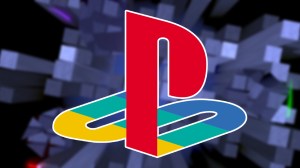
Today marks the third issue of Dark Knight III: The Master Race, Frank Miller’s latest installment in his best-selling series of politically-charged tales featuring an aging Batman squaring off against the world.
Videos by ComicBook.com
In The Master Race, of course, he’s teamed with co-writer Brian Azzarello, as well as the art team of Andy Kubert and Klaus Janson, who are doing their best to bring Miller’s world to life. A one-shot featuring art by John Romita, Jr. is also on the docket, along with mini comics drawn by Miller and included with the single issues of the series.
The issue is on sale at comic shops now and online, while both #1 and #2 are being reprinted as hardcovers, which fans can eventually collect together into a slipcase collection at the end of the 8-issue miniseries.
Kubert and Janson joined ComicBook.com to talk about the project.
Andy, you’ve done a lot of Batman prior to this but this is a different can of worms because it’s a very stylized version of Batman’s world. How much did the two of you guys work together in crafting what Andy’s version of Frank’s world would look like?
Andy Kubert: I have Frank’s work right next to me when I’m working. I want to get that flavor of what was being done with my work without copying what he did. Before I started, I did a lot of sketching, a lot of figure it out. Actually, did more thinking than anything just to get that point where it would be kind of a combination. It would be mostly me.
I didn’t want to, and I talked to Klaus about this too before I started…I didn’t want to emulate Frank. I had to have it be me or else my hands would have been tied as to what I was doing.
I kind of formulated and dialed down what I was doing from before on the previous Batman stuff and to try to figure out, and I sat down with Frank, too, to try to pick his brain as to figure out how he approached his art and things like that. I just sat down and put everything together and what you’re looking at is what I came up with. Then with Klaus inking it, it just pulls it all more so into the Dark Knight world. I find it couldn’t have worked out better.
Klaus Janson: You know, I think one of the … I love that question by the way, Russ. It’s a good question, because it makes me think about how much of Frank Miller has actually influenced us. All of us. There is a certain, almost a genetic imprint that some of us carry. I know I do. That is Frank Miller’s DNA. We’ve all looked at his work for the last 30 years or so and when I sit down and I start working on the Dark Knight world, there’s almost a trick or response.
The work kind of gears itself toward that look and I think what Andy has managed to do is pick up on certain characteristics of that world but also, very, very much so, interpret it his own way.
It’s not DK1 and it’s not DK2. There’s a flavor, of course, and there’s a continuity and consistency that’s carried throughout. It is its own book. It’s Andy’s look and it’s a different book but still familiar. I love that part of it.
You know, it’s funny. I think one of the things that stuck out at me, and you’re talking about how being the Dark Knight world it inherently shoves you that way. Carrie Kelley in particular feels to me very Frank. Her figure work feels less like most of the beautiful women you see Andy draw and there’s a very big piece of Frank’s DNA in that. Having her be such a big character, it almost kind of nudges the whole book that way.
Kubert: You want to know why? Frank and I went back and forth on character sketches with her. We went back and forth and he had a specific thing in mind as to what he was looking for so it was kind of cool that you picked that up.
Gotham is always kind of a living, breathing thing in Batman comics. Frank’s Gotham is a slightly different version of it. Do you think that one of the things that’s really challenging about what you guys are doing here is capturing Gotham?
Kubert: The way I approach Gotham City is it’s a character unto itself and there’s many incarnations of it. There’s incarnations that Anton first did from the first Batman movie. There’s incarnations that Neil Adams had done. Frank, but each one is a character unto itself. What I was doing is I was going along what Frank was doing and trying to put that character into Gotham, into itself. What else is a big part of it is not just the way Gotham is drawn on the panel but it is also where it’s placed. It’s also how it’s done with the negative space around it.
If you look at Frank’s Dark Knight stuff, especially in the first issue, you see these big pull-back shots and you’ll see Gotham City down below, very silhouette, with all of this negative, white sky space all around it. That sky space is just as important as the line art of Gotham City itself. It all intertwines and it all makes it for the character that it is, if that makes any sense. I don’t know.
Janson: If I may say, I think that Andy is completely correct. In a book like Batman, or a character like Batman, Gotham is such a major part of that series, but even in a very general way. What I so admire is, and what I always try to do with my own storytelling, my own penciling is the environment is very important in general. That it conveys so much information about the character, about the mood, about the feelings of the character without the words. To minimize the environment, like some artists do, I think is a minus in terms of their overall ability. What Andy’s doing is the correct approach to storytelling, to use the environment to convey information.
Frank’s use of negative space is one of the defining elements of his look. Klaus, having you on is really a big part of the Dark Knight equation. You’re always very, very open about your admiration for Frank, but you are one of the most respected inkers in probably comics history. How much do you feel you helped to push this into that direction?
Janson: Well, I think that at the very least there’s a … Well, I wouldn’t overstate my contribution. Well, maybe I would. At the very least there’s what I like to think is that I’m giving the series a bit of continuity or familiarity with the Dark Knight, the first Dark Knight.
If I can do that and contribute in that way, I’m certainly happy with that. I am a big admirer of Frank’s work and his composition, his use of black and white, his negative space and positive space. His storytelling. His rhythms. You know there’s a lot to learn from that and if I can help that and if I can help Andy, if I can help Brian, I’m more than happy to do that.
I’ve always found Andy’s figurework very kinetic, like your characters have a fluidity of motion which I wouldn’t necessarily associate with Frank. Frank’s storytelling work a bit differently than that a lot of the time. Is that something where you kind of look at your work. Going forward and four and five and the miniseries that are coming along, is it kind of trippy that Andy’s style is now part of the vocabulary of this world?
Kubert: I tell you, I draw the way I draw and I can’t change the way I draw as far as the way I perceive things. I can mess with styles a bit and compositions and storytelling and things like that, but as far as … It’s the way I am. Every artist is individual like that. I constructed anatomy a certain way and faces and hands. All that kind of stuff. It’s the way I perceive it and that’s a difficult thing, near impossible for an artist to change. Style is one thing but as far as the stuff that comes from within, it’s a gut feeling that comes out and it goes through the end of the day. That’s a very, very-
Janson: Andy, what do you think, Andy, is the percentage in terms of when you take on an assignment. Let’s say like DK3, you try to adapt a certain amount to a specific project, but the core part of you is still the same. To me, I always think like 90-10 or somewhere around there. What do you think in terms of percentage, how much can one adapt to a new project?
Kubert: I think it depends on the project. This one’s very…the percentages are high. To adapt a project like when I drew the Damian miniseries. That was straightforward, just me going balls-out. Whatever Happened To The Caped Crusader? that Neil Gaiman wrote. That one I had to adapt and that was story-specific, had to work off different styles and different eras from artists like Bob Kane and Neal Adams. People like that, even had to do Kelley Jones and all that kind of stuff.
I switched up styles. When I was at Marvel I worked on 1602 with Neil and Wolverine Origins. That was just strictly working from that was colors from pencil drawings but I had to work up a specific style. I wanted to develop a specific style that would work well with the color, with the way the color was being done. It’s very project-specific as to what-
Janson: Yeah, I think you’re right. Yeah, that makes sense.
Kubert: Even later on in life when my father did different projects like Yossel, which was pencil-specific, and the Jew Gangster thing, he switched it up, too. We all do that kind of thing and Klaus, he’s done that also.
When I look back at a lot of the 80’s and 90’s reprint material, when they try to re-color it, it always looks a bit odd. Frank and Klaus and Lynn Varley’s colors were such big part of the Dark Knight. Klaus, especially for you, is it something you have to be conscious of, working on this world but in a post-2010 where everything’s computer-colored. If not, it’s a very different look to superhero comics.
Janson: I’m very aware of coloring and we’re lucky enough to be working with Brad Anderson and we’re lucky enough to have input. Andy and I and Brian and Frank, into the coloring. You know, I’ve colored Frank on the last year of the Daredevil run. Part of that, part of what motivated me to do that was because I was …. I did not think that that the coloring fulfilled the vision that Frank and I had in the pencils and in the inks. If you get a shitty coloring job it really affects the work so I’m very aware of color and I would think Andy is, too, but in this case in Dark Knight, we’re really lucky to have Brad color the art. It’s a relief not to worry about it.
Kubert: Absolutely. Color makes or breaks. No matter what Klaus and I do, if the color is not there it’s not going to work. If the color is there, if it enhances, then it’s going to work. When Frank and Lynn and Klaus did the first Knight, that was all blue line color art at that time. Dark Knight 2, I think that’s when computers just started coming about. Photoshop was just coming around it was a band new medium.
Now, computer coloring has taken such a leap and so many different things can be done with it now. I will tell you though, there are some aspects of the blue line color art that I still prefer over digital coloring. There’s a roughness and a looseness and a spontaneity with it that I kind of prefer. That’s kind of why I prefer real inks to digital inks now. Digital inks, until it gets perfected, I think it takes away from art. I think inking with pens, brushes, that whole thing, adds to the art. Not only adds to it, but I think it’s part of the art. I think it’s the whole package.








